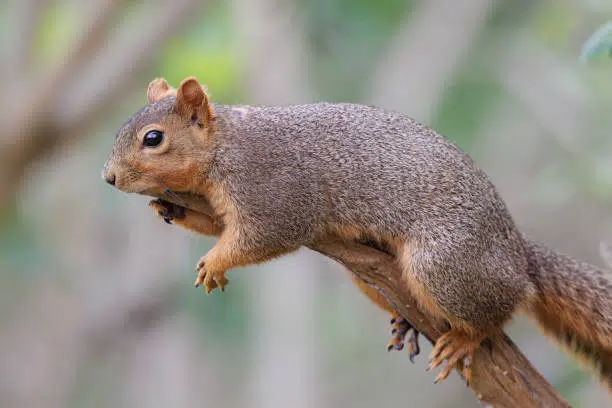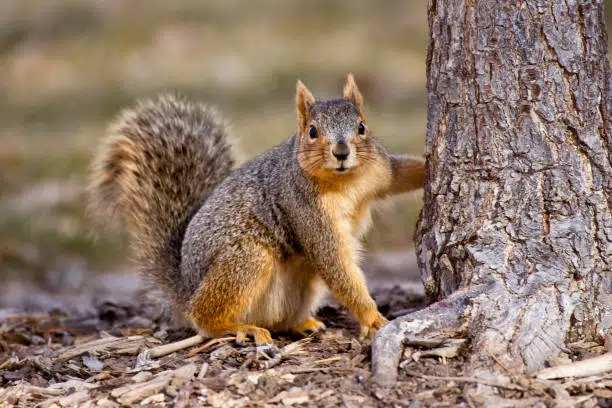Table of Contents
Scientific Classification
| Kingdom | Animalia |
| Phylum | Chordata |
| Class | Mammalia |
| Order | Rodentia |
| Family | Sciuridae |
| Genus | Sciurus |
| Species | S. niger |
| Scientific Name | Sciurus niger |
Description
Let me introduce you to the fox squirrel! This energetic little acrobat of the forest is well-known for its boundless enthusiasm and adorable appearance. As the largest tree squirrel species native to North America, these critters have a name that reflects their beautiful coat, which often resembles the warm, reddish-orange fur of a fox.
Typically, a fox squirrel measures between 18 to 28 inches long, with its fluffy tail stretching up to 13 inches! Adults usually weigh in at around 1.5 to 2.5 pounds. Their fur can vary quite a bit depending on where they live and the individual squirrel. You might see shades of cinnamon-brown, rusty orange, gray, or even black. Some populations have unique color variations; for instance, black squirrels can be spotted in parts of the southern United States, while silver-backed squirrels are found in the Appalachian region.
Those bushy tails aren’t just for show—they’re incredibly useful! They help with balance, communication, and keeping warm during the chilly winter months. With their big eyes for sharp vision and strong hind legs for impressive jumps, fox squirrels are perfectly adapted to life high up in the treetops.
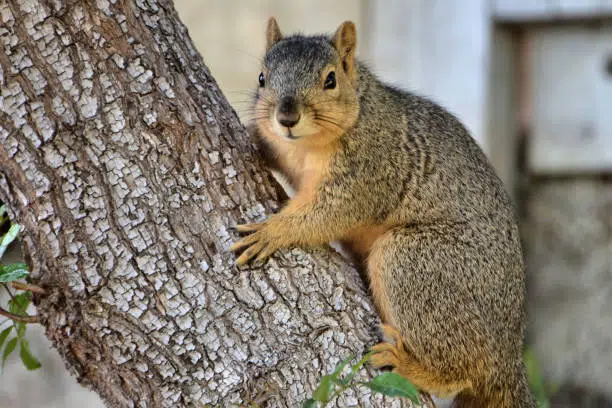
Distribution
Fox squirrels are quite the wanderers, boasting a wide-ranging presence across North America. They call the eastern and central United States their home, stretching all the way from the Atlantic Coast to the Great Plains. Their territory even extends into parts of Canada and northern Mexico. While they primarily hang out in the Midwest and Southeast U.S., some adventurous ones have made their way to the West Coast, finding cozy spots in urban parks and suburban neighborhoods.
Interestingly, the squirrels in different regions might show off unique color patterns or exhibit slight changes in behavior, all thanks to their local surroundings.
Habitat
Fox squirrels are quite the agile climbers, thriving in open woodlands where scattered trees create the perfect environment. They love a blend of hardwoods and nut-bearing trees like oak, hickory, walnut, and pecan. Thick forests? Not their scene. Instead, they gravitate towards open savannas or urban parks, which provide ample food and cozy nesting spots.
These clever critters also adapt beautifully to farmlands, golf courses, and city parks. As long as they can find trees for nesting and some good cover, along with plenty of food, they’ll make themselves right at home.
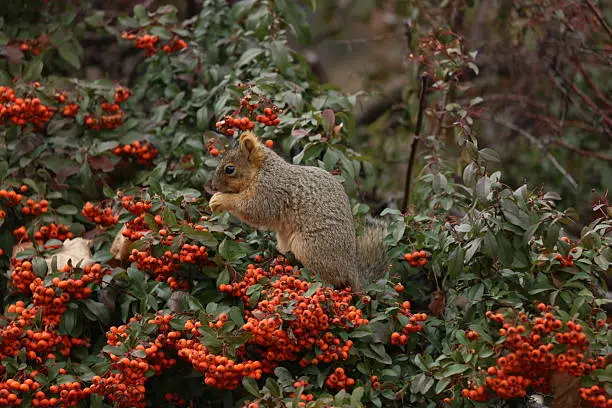
Diet
Fox squirrels have quite the diverse menu, munching on both plants and animals. Their eating habits shift with the seasons and what’s on offer. Here’s a peek at their favorite foods:
Nuts: acorns, hickory nuts, pecans, walnuts
Seeds: sunflower seeds, pine seeds
Fruits: apples, berries, mulberries
Green vegetation: buds, bark, leaves, and fungi
Insects and bird eggs (every now and then)
With their strong teeth, they’re perfectly equipped to crack open those tough nut shells. During the fall, fox squirrels stash away food in various spots to prepare for winter. Their impressive memory and sharp sense of smell come in handy for locating these hidden treasures. But sometimes, they forget a few, which is a happy accident that helps new trees sprout!

Behavior
Fox squirrels are primarily daytime creatures, waking up early in the morning and becoming active again in the late afternoon. They prefer to go solo, spending their time foraging, grooming, or soaking up the sun on a sturdy branch. While they’re not overly territorial, they will defend their nests or favorite food spots if necessary. They communicate through a variety of sounds and actions, like warning barks, chuckles, and tail flicks, which help them alert others to danger or ward off competitors.
Although fox squirrels are known for their tree-dwelling habits, they often venture down to the ground, especially when searching for food. Their strong claws and quick reflexes allow them to zip between trees, and they can easily escape into the canopy if they sense a threat.
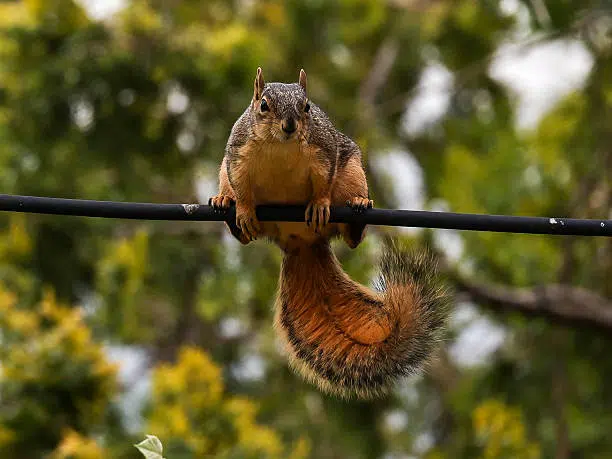
Lifespan
When it comes to lifespan, a fox squirrel typically lives between 6 to 12 years in the wild. Unfortunately, many of them don’t make it to old age due to threats from predators and various human-related dangers. In a safe environment like captivity, where they have regular food and protection, they can live as long as 18 years. The first year is particularly tough for them, as young squirrels often face dangers from predators, harsh weather, and accidents.
Reproduction and Lifecycle
Fox squirrels hit sexual maturity at about 10 to 12 months old. They typically mate twice a year: once in late winter, from December to February, and again in mid-summer, between June and August. During mating season, males often put on quite a show, chasing after females, and sometimes you’ll find as many as 10 suitors vying for the attention of a single female.
After a successful mating, the gestation period lasts roughly 44 to 45 days. A female usually gives birth to two to four kits, which are the little ones, but litters can range from one to seven kits.
When they’re born, kits are blind, hairless, and totally reliant on their mother. They stay in the nest for the first six weeks of their lives. Their eyes start to open around the five-week mark, and by eight to ten weeks, they’re ready to explore outside the nest. By the time they hit twelve weeks, they’re typically weaned and starting to learn how to fend for themselves.
Predators
Even though fox squirrels are quite nimble, they have to watch out for a variety of predators in the wild. Their main natural threats include:
Birds of prey: like hawks, owls, and eagles
Mammals: such as foxes, coyotes, and even domestic cats and dogs
Snakes: particularly those that climb trees
Humans: through hunting, road accidents, and the destruction of their habitats
Young squirrels are particularly at risk until they gain full mobility and climbing skills. Thankfully, these little critters have sharp senses and quick reflexes, which help them evade danger. They can swiftly dart up into trees and find refuge in their nests.
Adaptations
Fox squirrels are equipped with a range of adaptations that make them perfectly suited for life both in the trees and on the ground. Their powerful claws and flexible ankles allow them to climb down trees head-first with ease. The long, bushy tail they sport not only aids in balance but also serves as a means of communication and keeps them warm. With their varied colors, they can blend into different environments, providing effective camouflage. They possess a keen sense of smell, hearing, and vision, which helps them locate food and detect potential threats. Plus, their continuously growing sharp incisors are perfectly designed for gnawing through tough nuts and bark. Overall, fox squirrels have a mix of physical and behavioral traits that enable them to thrive, even in areas where humans are prevalent.
Nest
Fox squirrels are quite the architects when it comes to building their nests, known as dreys. You’ll typically find these cozy homes perched 30 to 45 feet up in the trees, often nestled in the forks of branches. They’re crafted from a mix of twigs, leaves, bark, and moss, giving them a somewhat chaotic appearance from a distance. But don’t be fooled—inside, they’re actually spherical and well-insulated, providing a snug refuge that keeps the squirrels warm and dry.
When the weather turns chilly or during the winter months, these clever critters might seek out tree cavities for extra shelter. These spots offer better protection from both predators and harsh weather. A female squirrel preparing for her little ones might even create several nests, rotating between them to ensure her safety.
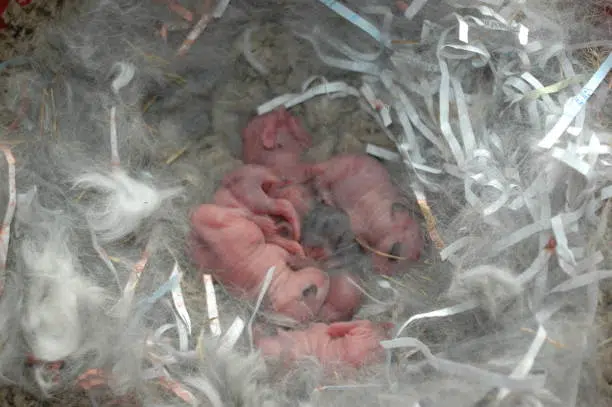
Mating Season
Fox squirrels have two mating seasons. The first is in late winter, usually starting in January or February. The second occurs in mid-summer, around June or July. These times align with the best chances for young to survive. It means they are born in spring and late summer, when food is plentiful.
In mating season, males often travel far and compete in chases. The dominant male often gets to mate. However, females usually choose their partners based on health and strength.
Breeding
Once the mating is done, the female takes the lead. She’s the one who builds the nest, carries the little ones, and looks after them. To make the drey cozy for her babies, she lines it with soft materials like grass, feathers, and leaves. Fox squirrels typically have two litters each year, but in some areas or under tough conditions, they might only manage one. The survival of the litter really hinges on the environment, available food, and any predator threats. After they’re weaned, the young ones start picking up foraging and climbing skills by watching and mimicking their mother.
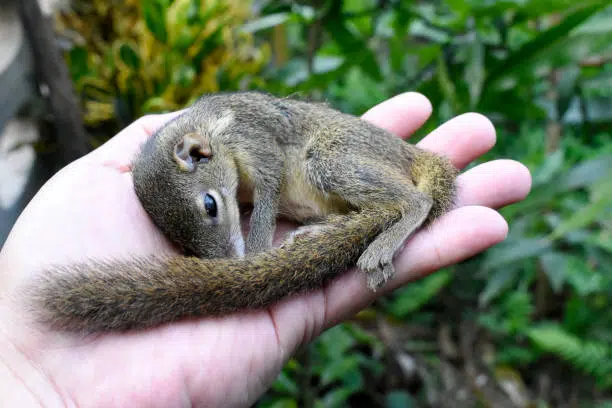
Interesting Facts
- Not really about foxes: Fox squirrels aren’t actually related to foxes. Their name comes from their fur color.
- Memory champions can hide hundreds of nuts. They remember exactly where each one is.
- Tail signals: Their tails serve as semaphores. They flash warnings or show aggression with clear movements.
- Urban dwellers: Fox squirrels thrive in cities. They often raid bird feeders and explore attics.
- Color morphs: Some areas have rare black or silver morphs. These are genetic variants that occur naturally.
- Buried nuts play a key role in ecosystems. When fox squirrels forget about them, the nuts can grow into trees. This makes the squirrels unintentional gardeners of the forest.
Conservation Status
According to the IUCN Red List, the fox squirrel is currently classified as a species of Least Concern. These little guys are quite common and boast a healthy population, so they’re not facing extinction at the moment. However, some subspecies, like the Delmarva fox squirrel (Sciurus niger cinereus), were once on the endangered list due to habitat loss. Thankfully, thanks to conservation efforts, they’ve made a comeback.
In certain areas, urbanization and habitat fragmentation pose challenges. Nevertheless, fox squirrels have demonstrated impressive resilience and adaptability. By protecting green spaces and forests, along with promoting road safety, we can help ensure that these charming rodents continue to thrive.
Conclusion
The fox squirrel is not just a furry friend in your yard. It is smart, adaptable, and important for the ecosystem. The fox squirrel is playful and helps forests grow. This shows us how nature is all connected. This lively rodent brings joy to wildlife watchers. Whether it’s leaping between trees or digging for acorns, it adds to North America’s natural beauty.
